Pablo Picasso – The Art and Controversies of the Famous Painter
Pablo Picasso is one of the most celebrated artists in history, whose impact on modern art cannot be overstated. Picasso is known for his influential contributions to the art movements of Cubism and Surrealism. Picasso’s artwork, ranging from paintings to drawings, continues to captivate audiences worldwide. Some of the most famous Pablo Picasso paintings include Les Demoiselles d’Avignon (1907) and Guernica (1937), both of which reflect his political and social views. Despite his passing, Picasso’s legacy lives on through his many works and memorable quotes, making Pablo Picasso’s biography an endlessly fascinating subject for art historians and enthusiasts alike.
Contents
- 1 Pablo Picasso: The Misogynist, the Canon, and the Balls
- 2 Pablo Picasso’s Biography
- 3 Something Really New: “When We Discovered Cubism, We Did not Have the Aim of Discovering Cubism”
- 4 The Last Phase: Exploration, Innovation, and Reinvention
- 5 The Legacy of Picasso: The Impact of Cubism on Art History
- 6 More Famous Picasso Paintings
- 7 Book Recommendations
- 8 Frequently Asked Questions
Pablo Picasso: The Misogynist, the Canon, and the Balls
In any discussion about Picasso, there are some controversial topics to consider. Questions like ‘Can we separate the artist from the art?’ and ‘Who are we overlooking in perpetually focusing on the same old artists?’ are important to ask before we delve into what made this talented individual so famous.
| Date of Birth | 25 October 1881 |
| Date of Death | 8 April 1973 |
| Country of Birth | Spain |
| Art Movements | Cubism, Surrealism, and Post-Impressionism |
| Genre/Style | Modern art |
| Mediums Used | Oil painting, collage, drawing, print-making, and sculpture |
| Dominant Themes | All aspects of life including sorrow, joy, pleasures, violence, socio-political issues, modernization, culture, and life in Europe |
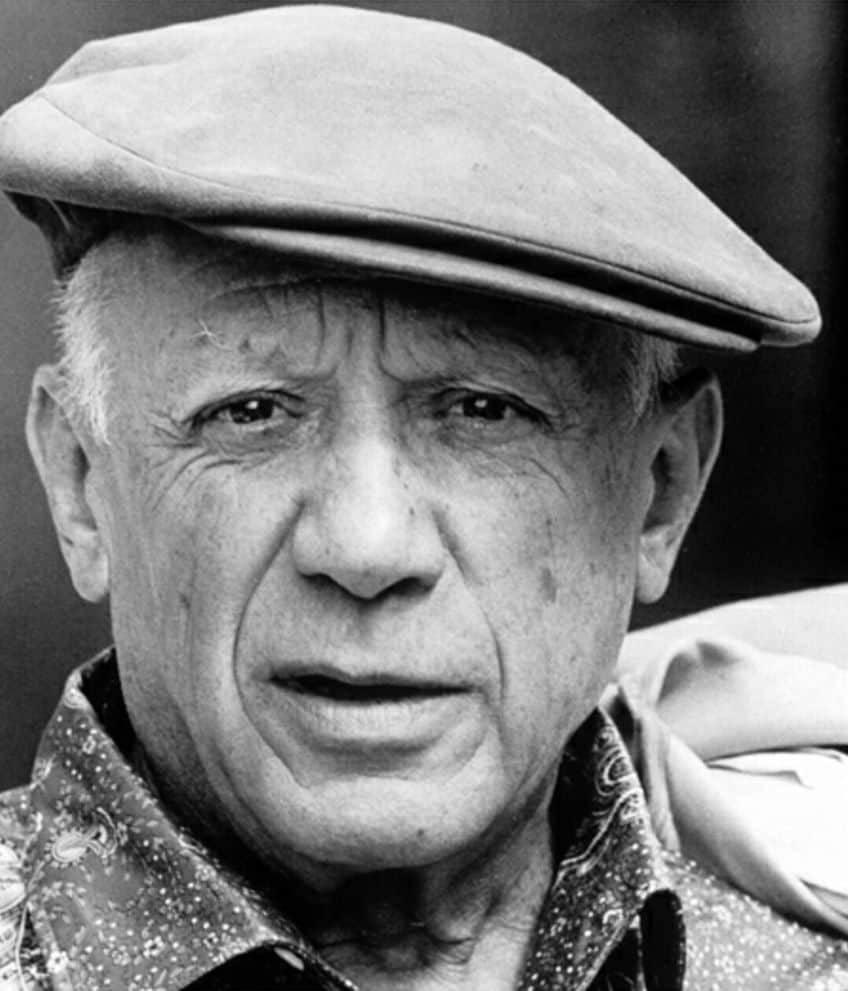
#MeToo Contestations
The #MeToo movement has sparked important discussions about the treatment of women in various fields, including the art world. One artist whose reputation has come under scrutiny in recent years is Pablo Picasso, who has been accused of being a misogynist.
Picasso’s relationships with women have been the subject of much debate, with some arguing that his treatment of women should diminish his reputation as an artist.
Picasso’s Thoughts About Women
Picasso had several tumultuous relationships with women throughout his life, including his long-term partner, Françoise Gilot, and his first wife, Olga Khokhlova. In his personal life, Picasso was known for his infidelities and his tendency to treat women poorly. He once famously stated, “For me, there are only two kinds of women: goddesses and doormats.” These comments and Picasso’s behavior have led some supporters of the #MeToo movement to argue that we should reevaluate our admiration for the artist’s work. They argue that the art world has long overlooked the way in which Picasso’s misogyny permeates his artwork. For example, many of Picasso’s paintings depict women in a sexualized and objectified manner.
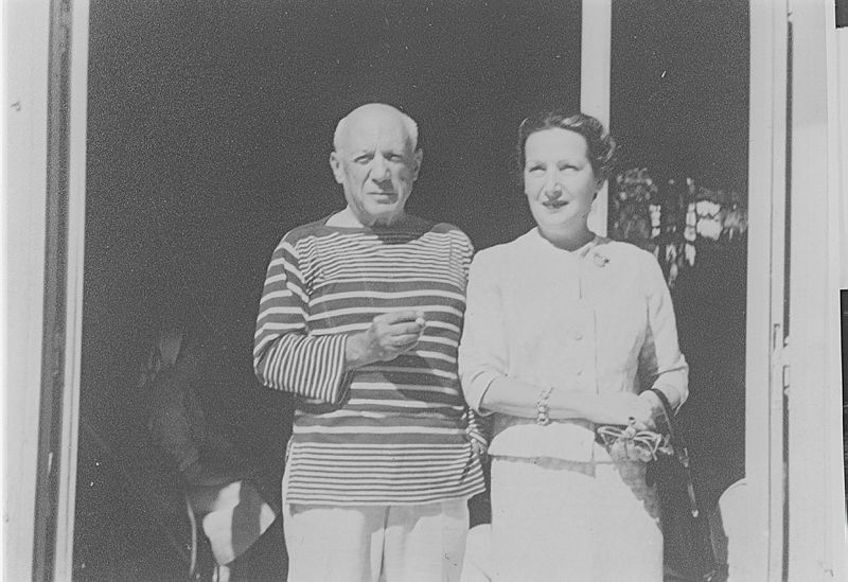
Men of His Day
However, others argue that we should separate an artist’s personal life from their art. Picasso’s artwork was groundbreaking and influential in the art world. Furthermore, some argue that it is important to view Picasso’s treatment of women in the context of his time. While his behavior towards women is unacceptable by today’s standards, it was not uncommon for men to behave in this manner during Picasso’s lifetime. Ultimately, the question of whether or not we should continue to praise Picasso’s artwork is a complex one.
While it is important to acknowledge the artist’s problematic behavior towards women, it is also important to recognize the ways in which his work has influenced and shaped the art world.
Pablo Picasso and the Western Art Canon
The Western art canon refers to a body of works that have been deemed historically significant and culturally valuable by Western societies. This canon includes works by famous artists such as Pablo Picasso, Vincent van Gogh (1853 – 1890), and Leonardo da Vinci (1452 – 1519). While the Western art canon has played a significant role in shaping the history of art, there are dangers to only focusing on artists in the canon.

A Narrow View
One danger of solely focusing on artists in the Western art canon is that it perpetuates a narrow and exclusionary view of art. The artists included in the canon are often white, male, and European, which overlooks the contributions of artists from other cultures and backgrounds. This perpetuates a Eurocentric view of art and limits our understanding of the diverse range of artistic practices that exist. Additionally, the Western art canon can reinforce elitism and a narrow view of art appreciation. The emphasis on a select group of artists can lead to the exclusion of other forms of art, such as street art, graffiti, and performance art.
This can create a barrier to entry for artists who do not conform to the traditional Western art canon and perpetuate a hierarchy of artistic value.
A Limited Context
Furthermore, focusing solely on artists in the Western art canon can lead to a limited understanding of the political and social contexts in which art is produced. The artists included in the canon are often from privileged backgrounds and may not reflect the experiences of marginalized communities. This can lead to a narrow understanding of art’s role in society and overlook the contributions of artists who have used their work as a means of social and political commentary.
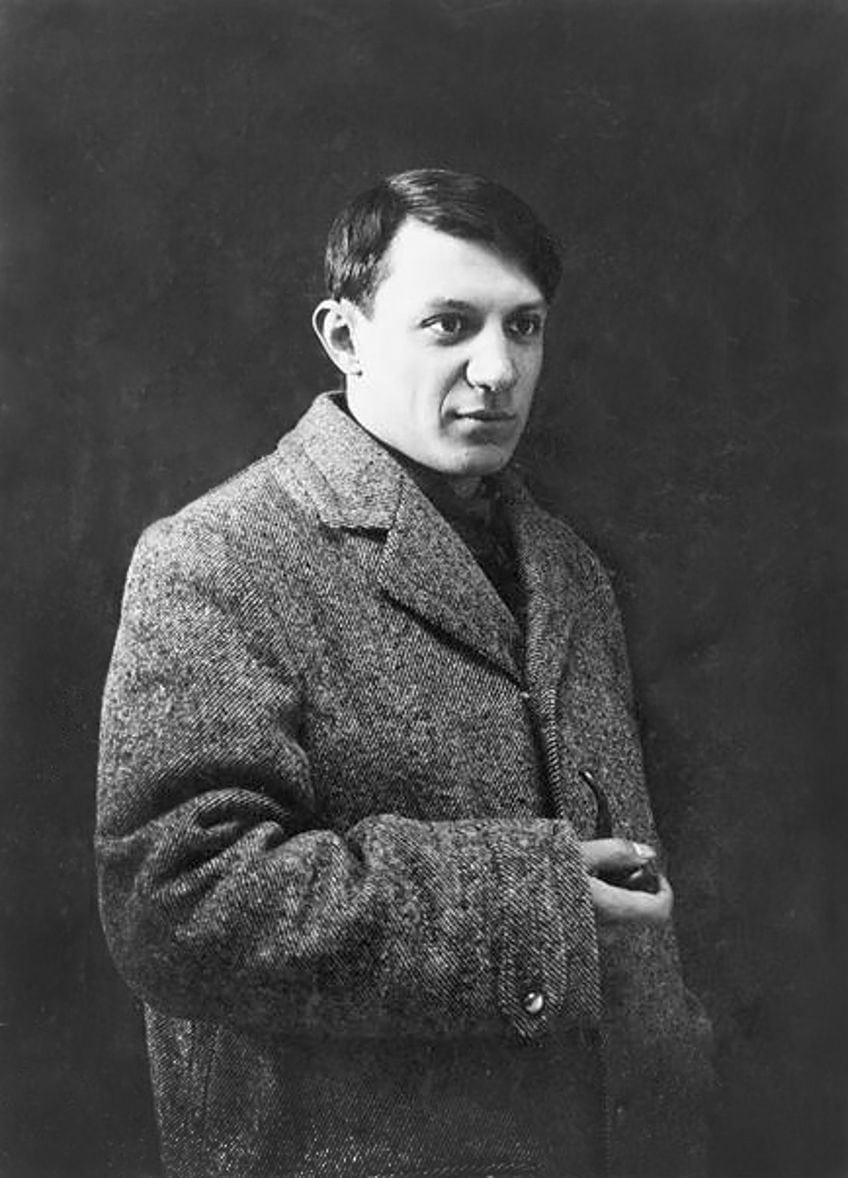
“The Balls”: Picasso’s Courage
Performance artist Marina Abramović recently posted a video on her Instagram stating, “Picasso definitely had very big balls”. This statement alludes to Picasso’s immense courage through his groundbreaking and pioneering career. Picasso was a courageous artist because he fearlessly broke from tradition and challenged the norms of his time. He was not afraid to experiment with different styles, techniques, and mediums, which resulted in groundbreaking works such as Les Demoiselles d’Avignon (1907) and Guernica (1937). These pieces were met with controversy and criticism, but Picasso persisted in creating work that was true to his vision. He also used his art as a means of social and political commentary, using his platform to express his views on war and injustice.
In all of these ways, Picasso was a bold and daring artist who was unafraid to take risks and push the boundaries of what was considered acceptable in the art world.
Pablo Picasso’s Biography
In this section of the article, we will go through Pablo Picasso’s biography and prolific career that spanned over seven decades and included an array of different styles, mediums, and techniques. We will answer questions like, “when did Picasso die?”, “when was Picasso born?” and mention a few famous Picasso quotes. We will also discuss how Picasso’s career led to the development of Cubism – the infamous art style that Picasso is most famous for.
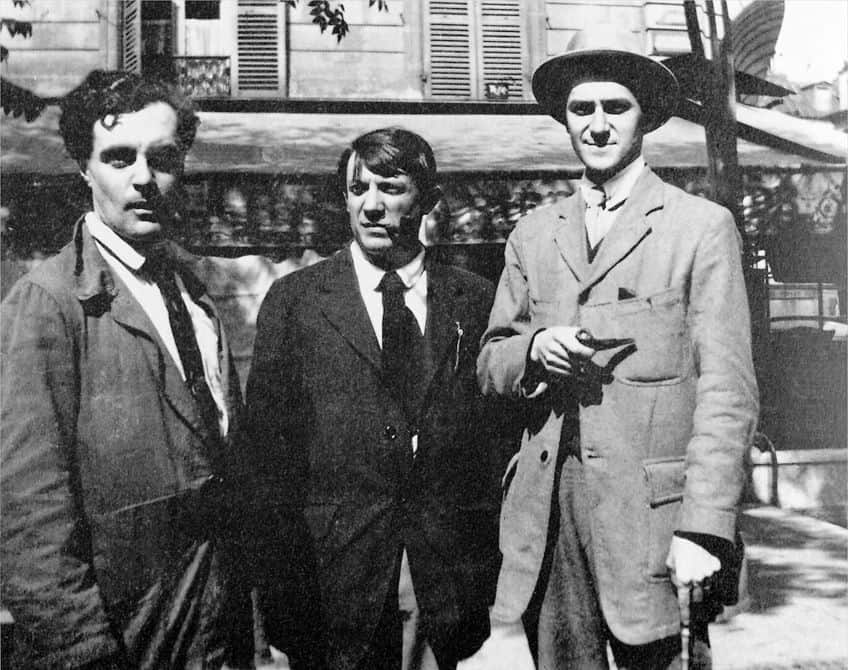
Early Life: “Every Child Is an Artist. The Problem Is How to Remain an Artist Once We Grow Up”
Pablo Picasso was born on October 25, 1881, in Malaga, Spain, to a middle-class family. His father was a painter and art teacher, which likely influenced Picasso’s early interest in art. The Picasso quote in the heading of this section was illustrated well throughout the artist’s life. By the age of 13, Picasso had surpassed his father’s artistic abilities and was admitted to the School of Fine Arts in Barcelona. He continued his formal art education in Madrid and later moved to Paris, where he began to develop his own unique style. One of his earliest works is First Communion (1896), which he painted at the age of 15.
This painting is a realistic portrayal of a religious ceremony and reflects Picasso’s skill as a painter at a young age.
Another notable work from his teenage years is Science and Charity (1897), which he painted at the age of 16. This painting depicts a doctor examining a sick child while a nun looks on, and demonstrates Picasso’s early interest in social and political themes. At the age of 16, Picasso also began his formal art training at the Royal Academy of San Fernando in Madrid, where he honed his skills and continued to develop his artistic style.
Moving to a Blue Paris: “It Takes a Long Time to Become Young”
When Picasso first moved to Paris in 1898, he was introduced to a vibrant art scene that was rapidly evolving. In the beginning phase of Picasso’s life in Paris, he went through very difficult things. He struggled financially, was still trying to develop his artist identity, and missed home. This dark age of his life and career was further triggered by Picasso’s good friend Carles Casagemas (1880 – 1901) taking his own life.
Furthermore, Picasso was influenced by the works of artists such as Henri de Toulouse-Lautrec (1864 – 1901) and Edgar Degas (1834 – 1917), as well as the emerging movements of Symbolism and Post-Impressionism. This led to a period of experimentation in Picasso’s work, during which he developed his own unique style.
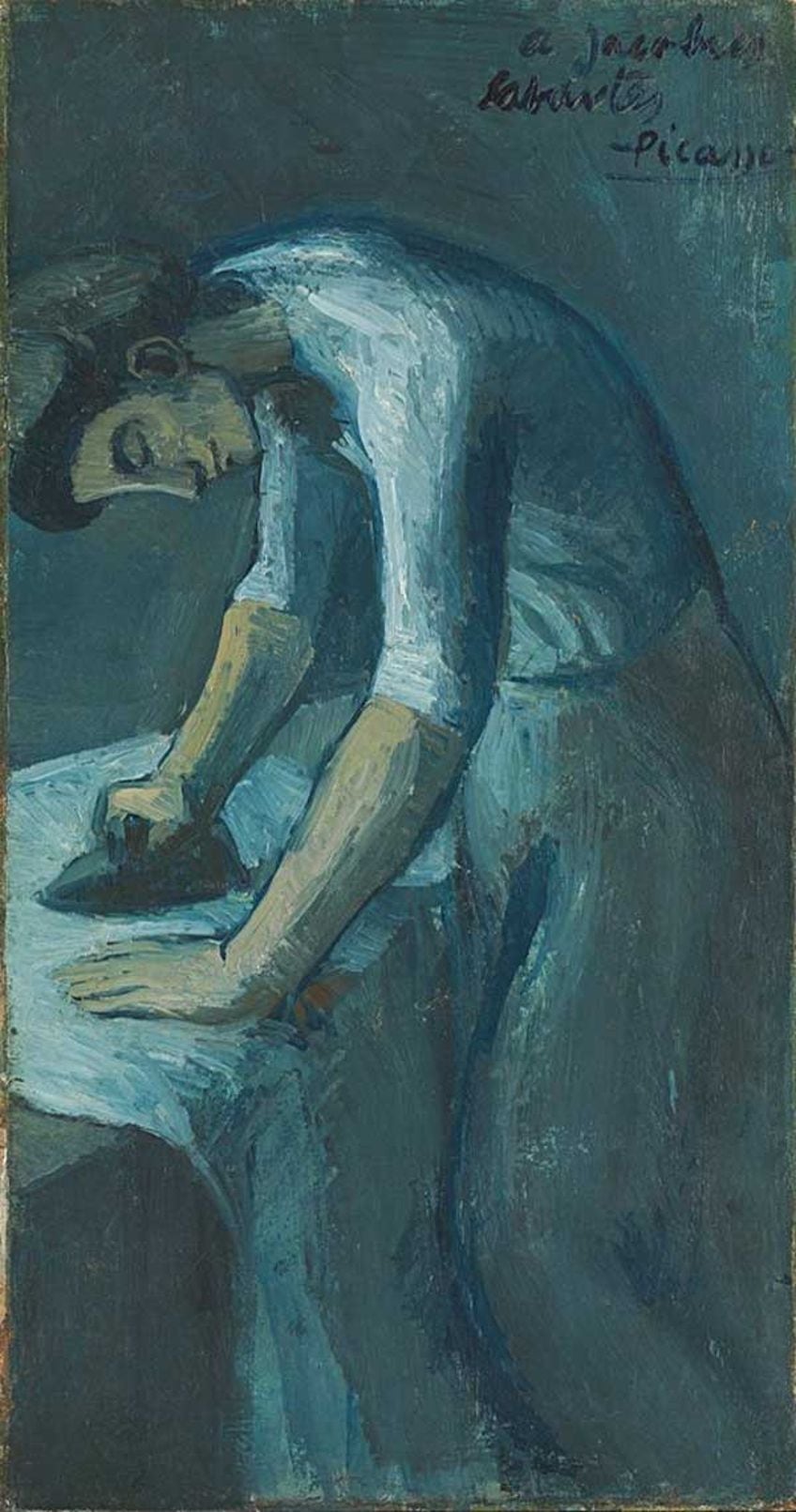
This period, known as the Blue Period, is characterized by somber, melancholic works that often feature blue tones and themes of poverty and isolation. Some significant paintings from this period include The Old Guitarist (1903), La Vie (1903), and Blue Nude (1902). These works demonstrate Picasso’s skill in capturing the human form and his ability to convey complex emotions through color and composition.
Overall, the period between 1898 and 1904 was a formative time in Picasso’s career, during which he developed the style and themes that would come to define his legacy as one of the greatest artists of the 20th century. The Picasso quote at the beginning of this section also illustrates the spirit of his time in his life, where he first went through a heavy and difficult time in his art before it became light, disruptive, and playful.
The Rose Period: “Love Is the Greatest Refreshment in Life”
The Rose Period of Picasso’s career, which lasted from 1905 to 1906, followed the Blue Period and was marked by a shift towards warmer colors and more optimistic themes. As the Picasso quote in the title eludes, this change was partly influenced by his personal life, as he fell in love with Fernande Olivier (1881 – 1966) and began to experience a period of happiness and contentment. During this time, Picasso also became interested in circus performers and harlequins, which became recurring motifs in his work.
Some significant paintings from this period include Boy Leading a Horse (1905 – 1906), Family of Saltimbanques (1905), and Acrobat and Young Harlequin (1905).
These works demonstrate Picasso’s skill in capturing movement and gesture, as well as his ability to convey complex emotions through color and composition. In comparison to the Blue Period, the Rose Period is characterized by a more vibrant color palette and a focus on scenes of leisure and entertainment. Overall, the Rose Period represents a significant period of growth and experimentation in Picasso’s career, as he continued to evolve and push the boundaries of artistic expression.
Something Really New: “When We Discovered Cubism, We Did not Have the Aim of Discovering Cubism”
Picasso’s development of Cubism can be traced back to his interest in the art of non-Western cultures, such as African masks and sculptures. This interest is evident in some of his early Cubist paintings, such as Les Demoiselles d’Avignon (1907) and Portrait of Ambroise Vollard (1910), which feature fragmented and distorted forms reminiscent of African art.

Braque and Picasso
Georges Braque (1882-1963) and Picasso’s collaborative efforts in Cubism began in 1908 when they started to experiment with techniques such as collage and papier collé (pasted paper) to create works that broke down the traditional boundaries between painting and sculpture.
This period, known as Analytic Cubism, is characterized by the use of monochromatic colors, overlapping planes, and a focus on dissecting form.
Analytic Cubism: Picasso Artwork Analysis
| Title | Portrait of Ambroise Vollard |
| Date | 1910 |
| Medium | Oil on canvas |
| Dimensions (cm) | 92 × 65 |
| Location | Pushkin Museum, Moscow, Russia |
Analytic Cubism was an innovative and revolutionary art style. It is characterized by the fragmentation and deconstruction of form, creating a new visual language that challenged traditional modes of representation. A perfect example of Analytic Cubism can be found in Picasso’s painting, Portrait of Ambroise Vollard (1910).
In this painting, Picasso uses a muted color palette of grays and browns to depict the art dealer Ambroise Vollard. However, the painting is not a straightforward representation of Vollard’s likeness. Instead, Picasso has broken down the image into a series of interlocking geometric shapes, which overlap and intersect to create a complex web of lines and planes.

The portrait is divided into a series of fractured planes, with the forms on the left side of the painting seems to push forward, while those on the right recede into space. This effect creates a sense of depth and dimensionality within the two-dimensional canvas, allowing the viewer to see multiple perspectives at once.
Picasso’s use of shading and tonal variation adds to the painting’s complexity, creating a subtle interplay of light and dark that emphasizes the fragmented nature of the image. The lines and planes of the painting intersect and overlap, creating a sense of dynamism and movement that draws the viewer’s eye across the canvas. Overall, Portrait of Ambroise Vollard is a perfect example of the qualities of Analytic Cubism.
It is a radical departure from traditional modes of representation, challenging the viewer to engage with a new visual language that emphasizes fragmentation and the deconstruction of form.
Synthetic Cubism: Picasso Artwork Analysis
| Title | Mandolin and Guitar |
| Date | 1924 |
| Medium | Oil on canvas |
| Dimensions (cm) | 200 × 141 |
| Location | Solomon R. Guggenheim Museum, New York City, United States |
After pioneering Analytic Cubism, Pablo Picasso, and Georges Braque developed a new style of Cubism known as Synthetic Cubism in the early 1910s. This style of art is characterized by the use of collages, the incorporation of real-world objects, and bright colors. Picasso’s Mandolin and Guitar (1924) is a perfect example of Synthetic Cubism.
In Mandolin and Guitar, Picasso uses a combination of painting and collage techniques to create a dynamic composition. The painting is made up of a series of flat, brightly colored shapes that are layered on top of one another to create a three-dimensional effect. This approach contrasts with Analytic Cubism, which sought to break down forms into their constituent parts and present them in a two-dimensional plane.
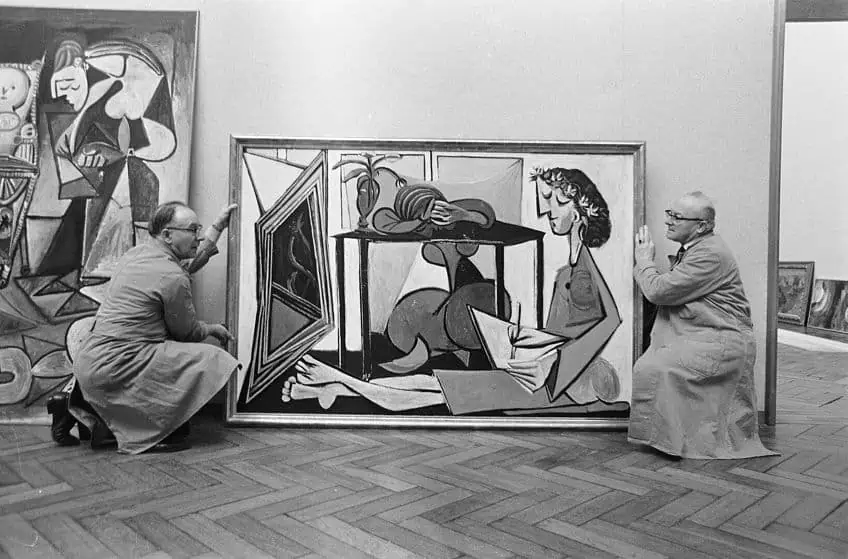
The painting includes several collaged elements, in the sense that the painted elements seemed collaged. These elements add texture and depth to the painting and provide a contrast to the flat, brightly colored shapes of the main composition.
The use of collage in Mandolin and Guitar is a hallmark of Synthetic Cubism, as is the incorporation of real-world objects (not seen in this painting). Real-world elements included in Synthetic Cubism artworks reflect the artists’ desire to move beyond the traditional boundaries of painting and explore new ways of creating art. The use of bright colors in Synthetic Cubism was also a significant departure from Analytic Cubism’s muted color palette.
In Mandolin and Guitar, Picasso uses a range of bright, contrasting colors to create a sense of energy and movement.
The Last Phase: Exploration, Innovation, and Reinvention
The last phase of Picasso’s art career, which encompassed the final years of his life from the 1960s until his death in 1973, was a period of prolific artistic exploration, innovation, and reinvention. During this time, Picasso continued to push the boundaries of traditional artistic norms and experimented with various styles, techniques, and mediums. One notable aspect of this phase was his return to figurative representation after a prolonged period of abstraction. He revisited earlier themes from his earlier periods, such as his famous Blue and Rose periods, and reinterpreted them with fresh perspectives.
One of the key highlights of Picasso’s later works was his mastery of drawing, which remained a fundamental skill that he honed throughout his career. Picasso’s drawings from this period are characterized by bold, expressive lines and dynamic compositions that exude a sense of spontaneity and creativity. He often used simplified forms and distorted figures to convey his emotional responses to the world around him.
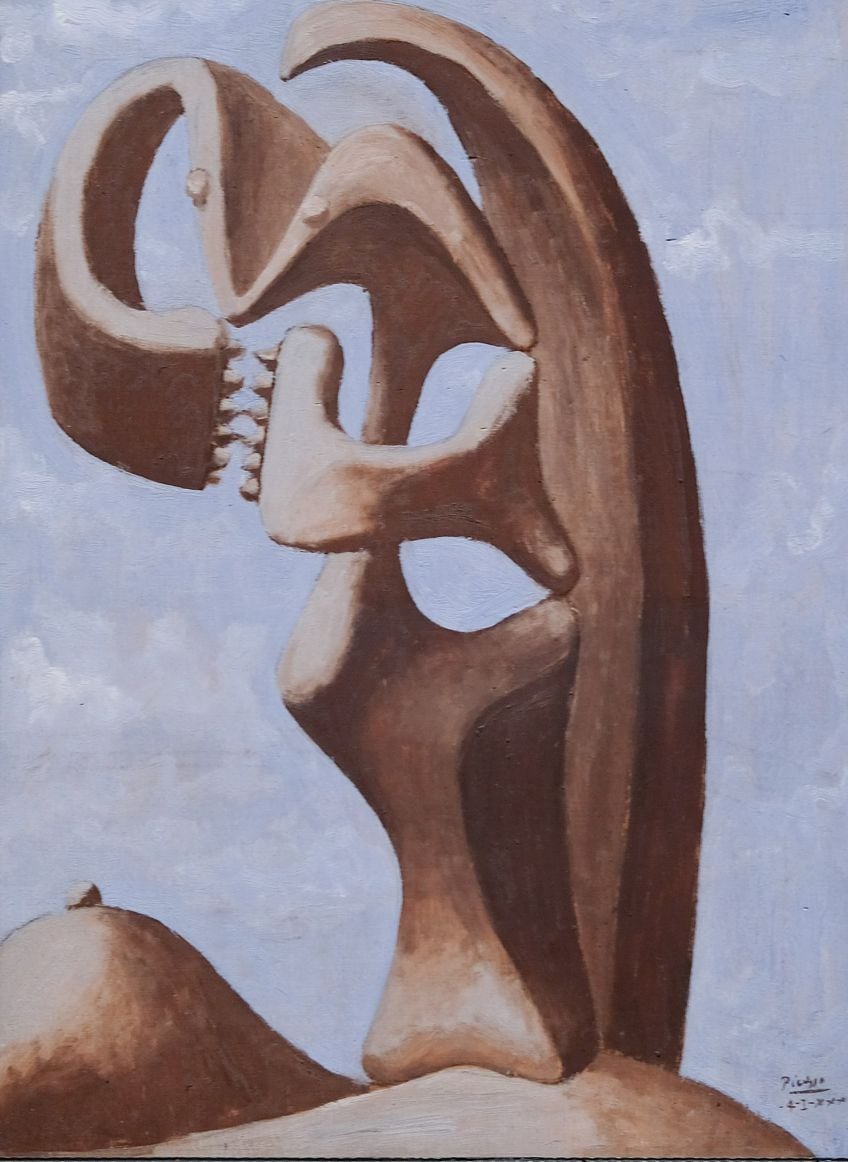
In addition to drawing, Picasso also ventured into sculpture, printmaking, and ceramics during his last phase. He continued to push the boundaries of these mediums, exploring new techniques and materials, and pushing the limits of form and structure. His ceramic works, in particular, were a significant departure from his earlier styles, featuring playful, whimsical forms and vibrant colors.
Another notable aspect of Picasso’s last phase was his continued engagement with political and social issues of his time. He used his art as a means of expressing his opinions and concerns about war, politics, and human rights, reflecting his deep commitment to activism and social justice. Despite his advancing age, Picasso’s creativity and artistic energy remained undiminished during his last phase. He continued to produce a large volume of artworks, constantly experimenting with new ideas and techniques.
His works from this period are a testament to his relentless pursuit of artistic innovation and his unwavering dedication to his craft.
The Legacy of Picasso: The Impact of Cubism on Art History
Cubism had a significant impact on the development of modern art, influencing movements such as Futurism, Dada, and Surrealism. Its influence can be seen in the work of artists such as Marcel Duchamp (1887 – 1968) and Jackson Pollock (1912 – 1956), who were inspired by the Cubist emphasis on the process of creation and the breakdown of form.
Despite its revolutionary impact, Cubism was not universally acclaimed. Some critics accused Cubist art of being too intellectual and lacking in emotion, while others saw it as a threat to traditional art and culture. However, the movement continued to thrive, and many artists were inspired by the Cubist emphasis on experimentation and innovation.
Picasso and Braque’s creation of Cubism was a radical departure from traditional methods of representation and opened up new avenues for artistic expression. Picasso, however, was such a versatile artist that his name is more widely known than Braque’s.
While Picasso is undoubtedly best known for his pioneering role in the development of Cubism, there were many other aspects of his long and illustrious career that made him one of the most famous artists of the 20th century. Over the course of his life, Picasso experimented with a wide range of styles and techniques, from his early works in the Blue and Rose periods to his later exploration of Surrealism, Neo-Classicism, and Expressionism.
He was also a prolific printmaker, sculptor, and ceramicist, and his work in these media helped to establish him as a master of modern art. Beyond his artistic achievements, Picasso was also known for his colorful personal life, which included numerous romantic relationships, friendships with prominent cultural figures, and a lifelong commitment to left-wing politics.
All of these factors combined to make Picasso one of the most influential and enduring figures in the history of art even after his death April 8 1973.
More Famous Picasso Paintings
Among the most famous Picasso paintings are Les Demoiselles d’Avignon (1907), Guernica (1937), and The Weeping Woman (1937). These Pablo Picasso paintings represent different periods in Picasso’s career and showcase his unique artistic style and techniques. Les Demoiselles d’Avignon shocked the art world with its bold depiction of prostitutes, while Guernica captured the horror of war and became an anti-war symbol. The Weeping Woman, painted in the aftermath of the Spanish Civil War, portrays a figure in agony and has been interpreted as a symbol of suffering and grief.
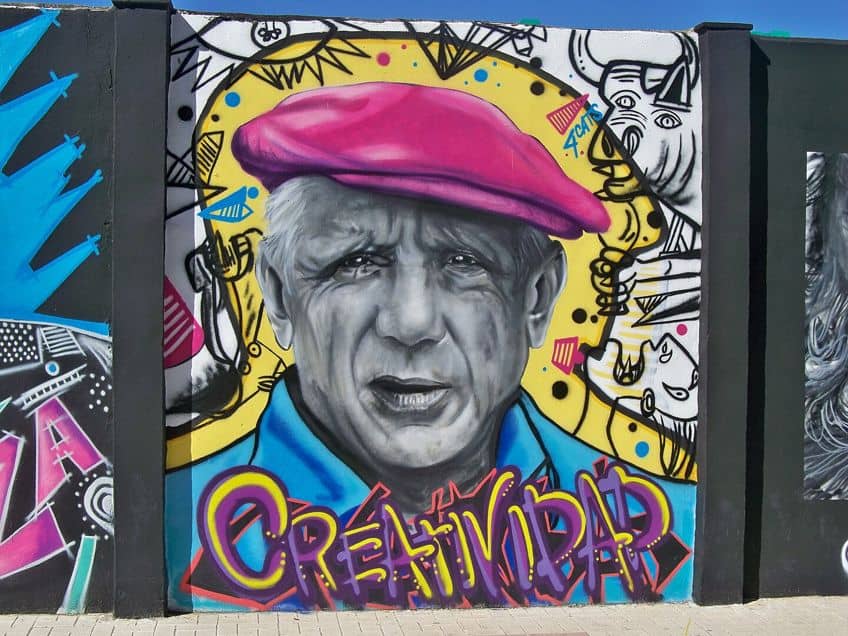
Les Demoiselles d’Avignon (1907)
| Date | 1907 |
| Medium | Oil on canvas |
| Type of Painting | Nude; still-life |
| Dimensions (cm) | 243.9 x 233.7 |
| Art Movement | Cubism |
| Location | The Museum of Modern Art, New York City, United States |
Les Demoiselles d’Avignon is a provocative painting by Pablo Picasso that depicts five naked women in a cramped space, posing for the painter or viewer. The background of distorted shapes and flat planes of color does not suggest any specific space, and the foreground has an unconventional still-life of fruit. This Pablo Picasso painting is hard to look at, but hard to look away from due to the seductive colors of fleshy pinks and beiges, contrasted with streaks of blue-green and white.
The women are painted in flat planes of color that fragment and splinter their form, removing their humanity and blending the line between looking at an individual or an objectified body.
The painting entirely abandons perspective and explores the two-dimensional plane of the canvas in a revolutionary way. The faces of the women are painted to look as if they are viewed from the front and side at the same time. The women’s gazes are confrontational, and their stances seem quite masculine, emphasizing their power and self-possession. Picasso objectifies their bodies, making their importance to this painting their stances and how they are drawing in the viewer, highlighting how sex workers were perceived at the time. On the other hand, the women’s confrontational gazes could be interpreted as a way for Picasso to empower them, destabilizing the understanding of their role to pleasure men.
Guernica (1937)
| Date | 1937 |
| Medium | Oil on canvas |
| Type of painting | History painting |
| Dimensions (cm) | 349 x 777 |
| Art Movement | Cubism |
| Location | Museo Reina Sofia, Madrid, Spain |
Guernica by Pablo Picasso is a powerful and haunting depiction of the tragedies of war, specifically the bombing of Guernica during the Spanish Civil War. The painting portrays the pain and grief of innocent individuals, particularly women, and children, who suffer the consequences of war. This Pablo Picasso painting is characterized by its stark black-and-white color palette, which resembles newsprint photographs and adds to the sense of drama and reportage. Picasso used a mixture of rural and epic painting styles, combining Cubist motifs of warped perspective and multiplicity of forms with Surrealist distortions of proportion.
The painting is filled with chaotic forms and movement, making it difficult to decipher whether the scene is indoors or outdoors, or whether it occurred during the day or night.
The painting features several prominent symbols, such as the bull and the horse, which hold varying interpretations and meanings. The bull, often associated with destruction, has been interpreted as representing fascism or even Picasso’s own ego in his other works. The horse, on the other hand, is seen as representing the people of Guernica, who are suffering and in pain. Picasso himself changed the meanings of these symbols in different paintings, adding complexity to their interpretation in Guernica.
Despite the varying interpretations, Guernica is widely seen as a symbol against war and an expression of peace. It is a poignant reminder of the devastating consequences of war on innocent civilians, and Picasso’s use of powerful imagery and artistic techniques in the painting conveys the horrors of war in a profound and unforgettable way.
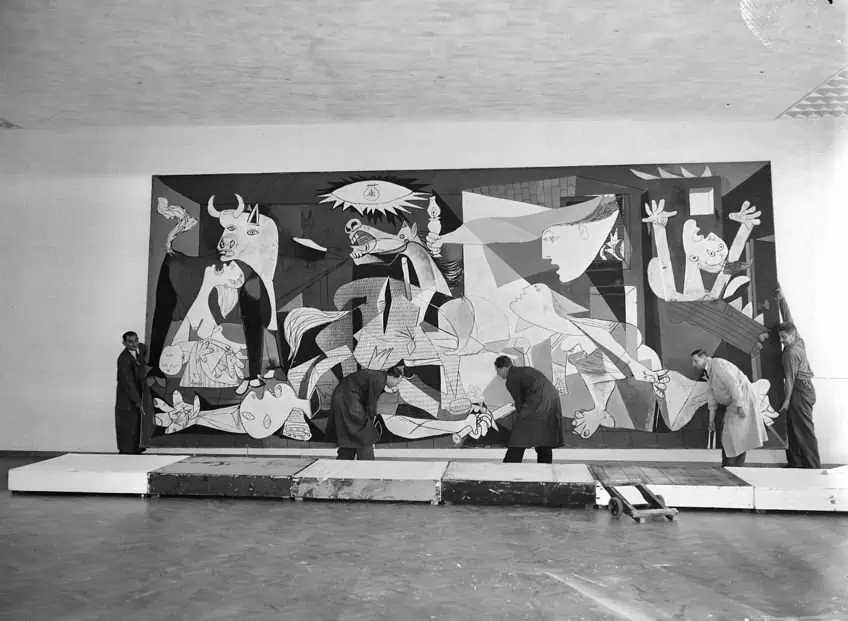
The Weeping Woman (1937)
| Date | 1937 |
| Medium | Oil on canvas |
| Type of Painting | Figure; portrait |
| Dimensions (cm) | 60 x 49 |
| Art Movement | Cubism |
| Location | Tate Gallery, London, United Kingdom |
Pablo Picasso’s painting The Weeping Woman is a poignant portrayal of human sorrow and tragedy amidst the horrors of war. The painting depicts a woman in profile, her face contorted in sorrow with closed eyes, holding a handkerchief to her face as if wiping away tears. Picasso’s use of Cubist perspective distortion adds complexity to the painting, showing the face from multiple viewpoints.
While the subject matter of the painting may seem simple, it carries deeper symbolism. Picasso painted this artwork, along with others in the series of crying woman paintings, in response to the bombing that was taking place in Spain during that time. The painting reflects the broader social and political climate in France, where Picasso was residing, during the period leading up to the Second World War, as people grappled with grief and the rise of fascism.
The color and light in the painting contribute to its somber mood. Picasso used a dark palette, with shades of gray dominating the woman’s face, and hints of red and blue highlighting her eyes and mouth.
The subdued and diffuse light adds to the overall sense of sadness and despair. The woman’s face stands out from her surroundings, which are more colorful, creating a feeling of her being trapped in her grief, disconnected from the world around her. The movement and texture in the painting are highly expressive, with bold brushstrokes and exaggerated forms creating a sense of dynamism and energy. The fragmented and disjointed nature of the woman’s face, with sharp angles and curves, conveys a sense of movement and tension, while the rough and impasto texture adds to the emotional intensity of the painting.
The perspective in the painting is unconventional and distorted, with foreshortening and spatial compression adding to a sense of unease and disorientation. The fragmented and disjointed elements of the painting seem to float in space, overlapping in a chaotic manner, further contributing to the overall feeling of emotional turmoil and anguish. Picasso’s use of line and form adds to the sense of tension and discomfort in the painting. Jagged and irregular lines, along with cut-up and disorganized forms, convey a sense of motion and energy, adding to the overall feeling of uneasiness and sadness.
This Pablo Picasso is rich in symbolism, with the woman’s tears representing the pain and suffering endured by the people of Spain during the Civil War. The fragmented and disjointed nature of the painting can be seen as a reflection of the chaos and violence of war. Overall, Picasso’s painting is a powerful portrayal of the effects of war on the human condition, and its themes remain relevant in today’s socio-political context.
Book Recommendations
Below is a list of excellent books on the life and art of Pablo. These books provide either a detailed account of the story of his life, give you a little more about the person behind the famous persona, or expand on his essential role as the father of modern art.
The books we have suggested are expertly curated, and any one of these would be a fantastic choice.
Pablo Picasso: 1881-1973 (1998) by Carsten Peter Warncke
If you’re a fan of modern art or interested in the life and works of one of the most influential artists of the 20th century, then Pablo Picasso: 1881-1973 (1998) by Carsten Peter Warncke is a must-read book. This comprehensive and beautifully illustrated book provides an in-depth exploration of Picasso’s life, career, and artistic evolution. From his early days in Spain to his rise to international fame in Paris, Warncke takes readers on a captivating journey through Picasso’s life, shedding light on his artistic development and the many genres and styles he explored throughout his career. Written in a clear and engaging style, Pablo Picasso: 1881-1973 is an authoritative and accessible book that offers a comprehensive overview of Picasso’s life and artistic achievements.

- A must-read comprehensive and beautifully illustrated book
- Trace the evolution of Picasso's life and artistic career
- Explore the many styles and genres of his prolific career
Pablo Picasso (2013) by Hajo Duchting
For those who want to explore the life and art of one of the most influential artists of the 20th century, Pablo Picasso (2013) by Hajo Duchting is an excellent choice. This comprehensive biography delves into the fascinating journey of Pablo Picasso, from his early years to his groundbreaking artistic achievements and lasting legacy. Duchting’s writing is engaging and accessible, making this book accessible to readers of all backgrounds, whether they are new to Picasso’s art or already familiar with his works. The book covers Picasso’s formative years, his artistic development, his major artistic periods including Cubism, Surrealism, and more, as well as his personal life, relationships, and creative process.
Duchting provides valuable insights into Picasso’s artistic techniques, themes, and influences, offering a deeper understanding of the artist’s groundbreaking contributions to modern art.
- A combined exploration of his personal life and artistic career
- A comprehensive biography tracing his major periods
- Perfect for those already familiar with his works or not
Picasso: Painting the Blue Period (2021) by DelMonico Books/Art Gallery of Ontario/The Phillips Collection
If you’re fascinated by the renowned Spanish artist Pablo Picasso and his iconic Blue Period, then Picasso: Painting the Blue Period is a must-read book. Published by DelMonico Books in collaboration with the Art Gallery of Ontario and The Phillips Collection, this beautifully designed and meticulously researched book offers a deep dive into one of Picasso’s most transformative artistic periods. Written with scholarly rigor and accessible prose, Picasso: Painting the Blue Period is a must-have for art lovers, scholars, and anyone interested in Picasso’s groundbreaking art and the significance of the Blue Period in his oeuvre. It is a visually stunning and intellectually enriching book that provides a captivating exploration of Picasso’s artistic genius and the profound impact of his Blue Period on the art world.

- An in-depth exploration of Picasso's iconic blue period
- Published in collaboration with the Art Gallery of Ontario
- A beautifully designed collection with detailed commentary
In conclusion, Pablo Picasso’s artistic genius continues to captivate and inspire art lovers and historians alike. His groundbreaking contributions to modern art, from his innovative paintings to his prolific and diverse Picasso drawings, have left an indelible mark on the art world. Picasso’s ability to push artistic boundaries, challenge conventions, and reinvent artistic styles has made him a legendary figure in art history. As a prolific and versatile artist, Picasso’s drawings serve as a testament to his creative genius and enduring legacy in the world of art.
Take a look at our Pablo Picasso paintings webstory here!
Frequently Asked Questions
When Was Picasso Born?
Pablo Diego José Francisco de Paula Juan Nepomuceno María de los Remedios Cipriano de la Santísima Trinidad Ruiz y Picasso, known as Pablo Picasso, was born on October 25, 1881 in the city of Málaga, located in the region of Andalusia in southern Spain. Picasso was born into a middle-class family, with his father being a painter and an art teacher. His early exposure to art and creative influences within his family likely played a significant role in shaping his artistic talent from a young age. Growing up in a vibrant artistic and cultural environment, Picasso’s birthplace and childhood experiences in Spain would later influence his art and contribute to his unique artistic style that would revolutionize the art world.
When Did Picasso Die?
Pablo Picasso passed away on April 8, 1973, at the age of 91 in Mougins, France. Mougins is a small town located on the French Riviera, where Picasso settled in the latter part of his life. After a prolific and groundbreaking career as one of the most influential artists of the 20th century, Picasso died in his sleep due to heart failure. His passing marked the end of an era in art history, leaving behind a rich legacy of innovative artwork that continues to inspire and captivate art enthusiasts and scholars worldwide.
What Made Picasso Such a Skillful Artist?
Pablo Picasso’s remarkable artistic skills were multifaceted, but one aspect that set him apart was his exceptional drawing ability. From a young age, Picasso demonstrated a prodigious talent for drawing, honing his skills through dedicated practice and experimentation throughout his career. He had an unparalleled ability to capture the essence of a subject with just a few bold strokes, distilling complex forms into simple yet powerful lines. His mastery of line, form, and composition allowed him to create groundbreaking artworks that challenged traditional notions of representation and perspective. Picasso’s drawings laid the foundation for his revolutionary approach to art, enabling him to push the boundaries of artistic expression and leave an indelible mark on the art world.
What Are a Few Rarely Known Pablo Picasso Facts?
Beyond his legendary artistic prowess, Pablo Picasso was a multifaceted individual with a fascinating life. Here are a few lesser-known facts about the iconic artist. Picasso was an accomplished poet and playwright, and he often incorporated his own writings into his artwork. He was also an avid animal lover and kept a variety of pets, including a goat named Esmeralda and a monkey named Moko. Picasso was known for his bohemian lifestyle, and he had a unique sense of fashion, often wearing unconventional clothing and accessories. Additionally, Picasso was an enthusiastic collector of African and Oceanic art, which greatly influenced his own artistic style. These lesser-known aspects of Picasso’s life provide insight into his complex personality and diverse interests beyond his artistic talents.
Nicolene Burger, a South African multimedia artist and creative consultant, specializes in oil painting and performance art. She earned her BA in Visual Arts from Stellenbosch University in 2017. Nicolene’s artistic journey includes exhibitions in South Korea, participation in the 2019 ICA Live Art Workshop, and solo exhibitions. She is currently pursuing a practice-based master’s degree in theater and performance. Nicolene focuses on fostering sustainable creative practices and offers coaching sessions for fellow artists, emphasizing the profound communicative power of art for healing and connection. Nicolene writes blog posts on art history for artfilemagazine with a focus on famous artists and contemporary art.
Learn more about Nicolene Burger and about us.
Cite this Article
Nicolene, Burger, “Pablo Picasso – The Art and Controversies of the Famous Painter.” artfilemagazine – Your Online Art Source. September 29, 2023. URL: https://artfilemagazine.com/pablo-picasso/
Burger, N. (2023, 29 September). Pablo Picasso – The Art and Controversies of the Famous Painter. artfilemagazine – Your Online Art Source. https://artfilemagazine.com/pablo-picasso/
Burger, Nicolene. “Pablo Picasso – The Art and Controversies of the Famous Painter.” artfilemagazine – Your Online Art Source, September 29, 2023. https://artfilemagazine.com/pablo-picasso/.






